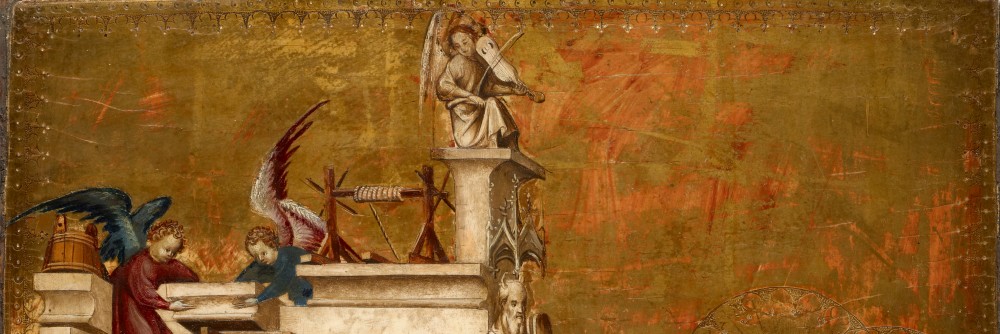[In the course of the cataloguing project Musikalische Quellen (9.-15. Jahrhundert) in der Österreichischen Nationalbibliothek (Musical Sources (9th-15th Century) in the Austrian National Library), conducted by Alexander Rausch and Robert Klugseder at the Austrian Academy of Sciences, Klugseder has discovered a startling number of hitherto unknown fragments at the Austrian National library and made these “Vienna Fragments” available online in high-resolution images. All links to the source and the catalogue entries go to the homepage of this project.]
Codex A-Wn Cod 5455 belonged to the artistic faculty of Vienna University and is dated to c.1385 (see catalogue) due to its contents and the signatures of several students from the late 14th to the early 15th century. It comprises university lecture material by Marsilius von Inghen (teacher at Paris University and first rector of Heidelberg University) and one Hugo de Reyss.
Fol. 180v of the manuscript features a single page with musical notation which is of some interest to our own project (“Musical Life of the Late Middle Ages in the Austrian Region”). This is one of the few examples of secular music which can be directly linked to university circles, and it fits the other known transmissions very well (e.g. the Eghenvelder Liedersammlung and the musical scribbles on the cover of A-Wn cod 5458—see the preceding blog entry): The textless lines with German incipits are reminiscent of sources with monophonic songs, such as the German lied “tenors” which can be found in the Strasbourg Codex CZ-Pu XI.E.9 (e.g. fol. 261v), Melk D-M cod 700 (pastedown of the back cover) and the only recently discovered notation on A-Wn Cod 5458 (front cover—for an in-depth analysis see this earlier post). The notation is typical for the transmission of late medieval German monophony and employs a mixture of purely melodic, unrhythmised “puncta” in the shape of semibreves and an element of stroke-notation for longer note values such as cadence notes (for similar notations see I-STEcap s.s. (Sterzinger Miszellaneen-Handschrift), A-Wn Cod 2856 (Mondsee-Wiener Liederhandschrift), A-Wn s.n. 3344, fol. 100v–fol. 115r (Eghenvelder Liedersammlung—in order to access individual pages, exchange folio number in the link), A-Wn Cod 4696 (Lambacher Liederhandschrift), D-ROu phil. 100/2 (Rostocker Liederbuch), D-Bsb Mus.ms.40613, pp. 44–45 (Lochamer Liederbuch), D-Mbs cgm 715, among others). Only the last melody (“Maý etc”) appears to employ a more consequent approach to stroke notation, offering an almost coherently rhythmised melody. Even though the source at hand is strictly speaking not a fragment, its state of preservation is not very good, for the ink has faded and the folio is clipped on one side.
The page transmits seven lines of musical notation on eight systems with four barely decipherable German incipits or titles which correspond to the notations of four separate melodies. My transcriptions of these incipits are as follows:
- Pärlein vnd mit (Monk of Salzburg)
- An czal dý etc
- Paradys ich han gesúcht
- Maý etc
A noteworthy aspect of these melodies is that they do not feature any repetitions of form parts (with the possible exception of the fourth one—”Maý etc”—which seems to feature some sort of AA’B structure, but which stands out in other respects as well). It may be that repetitions were intended but neither notated nor marked in this manuscript. A closer inspection, however, reveals that they seem to have been notated in full and that no repetitions were intended. Another interesting feature is that all four melodies seem to have been originally texted and would have started with a textless opening melisma. This fact cannot be proven until texted concordances have been found for all four pieces, however, their notational and structural characteristics point in this direction.
The second of these melodies (“An czal dý etc”) sounds so hauntingly familiar and like a number of secular pieces from the œuvre of the Monk of Salzburg that I looked for concordances there—only to find not the second but the first melody to be a new concordance to one of his pieces. [2015-02-28 addition: In fact it turned out to be a well-known tune. See the blog post: A New Concordance to “Czaldy waldy”.] The next four blog entries (see the linked incipits above) give transcriptions of these melodies and present a new concordance to a song by the Monk of Salzburg, namely “Pey perlin vnd pey spangen”. I am fairly positive that more concordances to the three [now: two] remaining melodies will be found in due time.
Marc Lewon
 This work is licensed under a Creative Commons Attribution-NonCommercial-ShareAlike 4.0 International License.
This work is licensed under a Creative Commons Attribution-NonCommercial-ShareAlike 4.0 International License.
